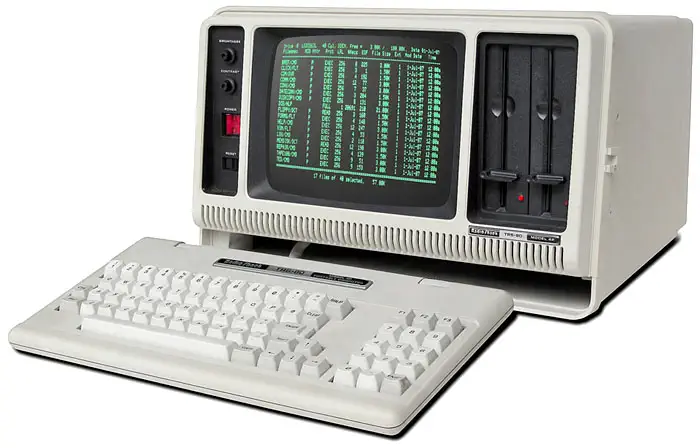TRS-80 Model 4
The TRS-80 Model 4 is the last z80-based home computer produced by Radio Shack. It was sold from 1984 through 1991.
The Model 4 was introduced as the successor to Model III. It came with a Z80A, running at 4 MHz, had a larger video display of 80 columns by 24 rows, and the memory could be upgraded to 128KByte. Model 4 was compatible with the Model 3 and could run Model III software as well as all CP/M software.
The TRS-80 Model 4 came in a few configurations:
- Diskless, 16KB RAM for $999
- Single sided 180K Disk Drive, 64KB RAM for $1699
- Two 180K Disk Drives and 64KB RAM for $1999
Model 4 shipped with TRSDOS 6, which is identical to Logical Systems LDOS 6.00. When the machine boots into TRSDOS, the video display switches to 80x24 mode and the entire 64KByte address space is mapped as RAM. Model 4 can run CP/M without any modification. Digital Research produced a version of CP/M 3.0 for the Model 4.
Displayed above is the TRS-80 Model 4P, this was a luggable version of the Model 4.
Zilog Z80 CPU Family
The Z80 quickly became popular in the personal computer market, with many early personal computers, such as the TRS-80 and Sinclair ZX80, using the Z80 as their central processing unit (CPU). It was also widely used in home computers, such as the MSX range, SORD, and the Amstrad CPC, as well as in many arcade games. Additionally, it was also used in other applications such as industrial control systems, and embedded systems. The Z80 was widely used until the mid-1980s, when it was gradually replaced by newer microprocessors such as the Intel 80286 and the Motorola 68000.
The Z80 microprocessor was developed by Zilog, a company founded by Federico Faggin in 1974. The Z80 was released in July 1976, as a successor to the Intel 8080. It was designed to be fully compatible with the 8080, but also included new features such as an improved instruction set, more powerful interrupts, and a more sophisticated memory management system.
The Z80 quickly became popular in the personal computer market, with many early personal computers, such as the TRS-80 and Sinclair ZX80, using the Z80 as their central processing unit (CPU). It was also widely used in home computers, such as the MSX range, SORD, and the Amstrad CPC, as well as in many arcade games. Additionally, it was also used in other applications such as industrial control systems, and embedded systems. The Z80 was widely used until the mid-1980s, when it was gradually replaced by newer microprocessors such as the Intel 80286 and the Motorola 68000. The design was licensed to Synertek and Mostek as well as the European SGS.
The Z80s instruction set is binary compatible with the Intel 8080, so that 8080 code such as the CP/M Operating System and Intel's PL/M compiler for the 8080 can run unmodified on the Z80. The Z80 had many enhancements over the 8080 such as 16-bit data movement instructions, block copy and block I/O instructions, single bit addressing of all registers, IX/IY offset registers, better interrupt system and a complete duplicate register file for context switching during an interrupt.
Source: WikiPedia

RAM max: 640kB Sound Chip none Sound Beeper Display 40x24, 80x24 text, 640x240 optional graphics Best Text 80x24 Best Color none Best Graphics 640x240 (optional) Sprites none System OS TRS-DOS Original Price $1999


